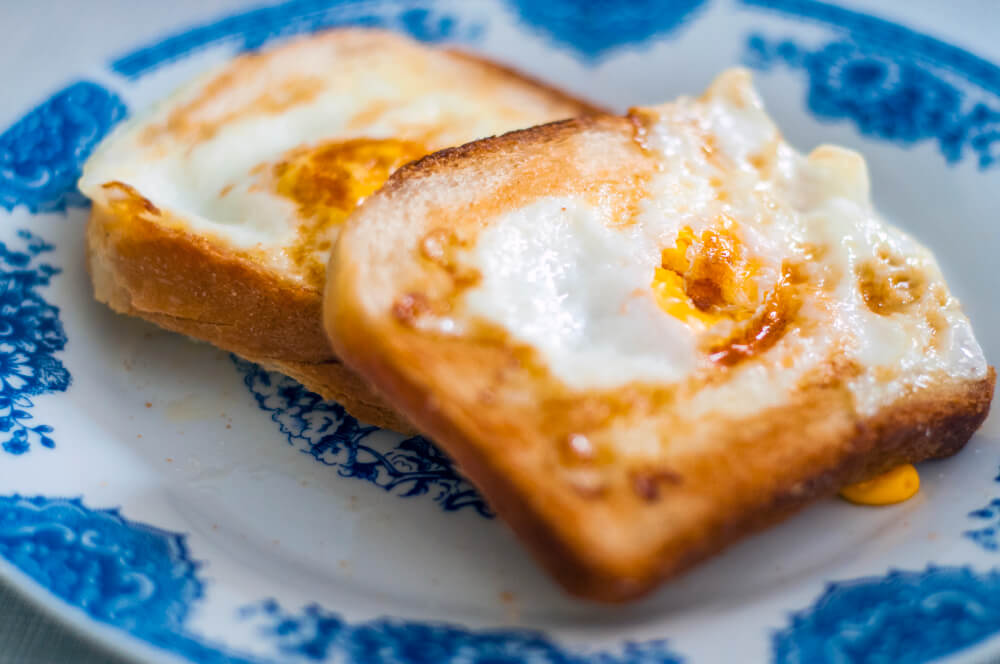Introduction to Buttermilk French Toast
French toast, a dish beloved across the globe, finds its origins in ancient times, long before it became a brunch staple. Historically known as ‘lost bread’ due to its technique of reviving stale bread, French toast has evolved into a culinary canvas for creativity and flavor.
The introduction of buttermilk into French toast is a relatively modern twist that has gained popularity for its ability to elevate this classic dish. Buttermilk, with its slightly tangy and rich profile, not only enhances the taste but also contributes to a more tender and plush texture. Unlike regular milk, the acidity in buttermilk reacts with the bread, creating a subtle complexity in flavor that sets it apart. This unique aspect has turned buttermilk French toast into a sought-after variation, combining the comforting familiarity of the traditional recipe with a refreshing new taste experience.
Buttermilk French Toast : Ingredients and Variations
Key Ingredients of Buttermilk French Toast
The journey to creating the perfect buttermilk French toast begins with two essential components: buttermilk and the right kind of bread.
- Importance of Buttermilk: Buttermilk is the cornerstone of this dish, offering a unique tanginess and a creamy texture that enriches the toast. Its acidity not only imparts a subtle tang but also interacts with the bread, making it tender and enhancing its ability to absorb the egg mixture without becoming too soggy.
- Choice of Bread: The selection of bread is equally crucial. Challah and Brioche are popular choices due to their rich, eggy nature and sturdy structure. These types of bread are dense enough to soak up the buttermilk mixture without disintegrating, resulting in a toast that’s crispy on the outside and soft on the inside. Their subtle sweetness also complements the tang of the buttermilk beautifully. Epicurious offers a classic recipe that perfectly highlights these ingredients.
Ingredient Variations
While the classic recipe is a delight, there’s room for experimentation and personalization.
- Substitutes for Buttermilk: If buttermilk isn’t available, you can create a similar effect using milk mixed with a tablespoon of lemon juice or vinegar per cup of milk. This mixture should sit for about five minutes before use. Another alternative is to use plain yogurt diluted with a bit of milk or water to reach a buttermilk-like consistency.
- Sweet vs Savory Options: The versatility of French toast allows for both sweet and savory variations. For a sweet version, ingredients like cinnamon, vanilla extract, or even a dash of nutmeg can be added to the mix. For those who prefer a savory twist, incorporating herbs like thyme or rosemary, or even cheese, can create a delightful breakfast or brunch dish. A Pretty Life in the Suburbs provides excellent ideas for variations.
Check out this Anabolic French Toast recipe.
Step-by-Step Cooking Guide For a Buttermilk French Toast
Preparation Steps
Creating the perfect buttermilk French toast involves a careful balance of mixing, soaking, and cooking techniques.
- Mixing: Begin by whisking together the buttermilk, eggs, and a sweetener like sugar or honey in a bowl. The key is to achieve a homogeneous mixture that will evenly coat the bread. For added flavor, consider incorporating spices like cinnamon or a dash of vanilla extract.
- Soaking: Once your mixture is ready, it’s time to soak the bread. Lay the bread slices in a single layer in a shallow dish and pour the buttermilk mixture over them. Allow the bread to soak for about 20 to 30 minutes, turning once halfway through. The goal is for the bread to absorb the mixture thoroughly but not become overly soggy. If the bread is too wet, it might fall apart during cooking; if it’s too dry, it won’t have that delightful custardy interior.
- Cooking: Heat a nonstick skillet or griddle over medium heat and lightly butter it. Once hot, place the soaked bread slices on the skillet. Cook each side until it’s golden brown and crispy, usually about 3 to 4 minutes per side. Be careful not to overcrowd the pan, as this can lead to uneven cooking.
Cooking Equipment
The choice between a nonstick skillet and a griddle comes down to personal preference and the number of servings required.
- Nonstick Skillet: Ideal for smaller batches, a nonstick skillet provides excellent heat control and is perfect for achieving a crispy exterior and evenly cooked interior. It’s also easier to handle for those less experienced in the kitchen.
- Griddle: A griddle is more suitable for larger batches. It offers a more extensive cooking surface, allowing you to cook multiple slices at once. This is particularly useful when preparing breakfast for a family or a group. However, maintaining an even temperature across the griddle is crucial for consistent results.
Customization and Serving Suggestions
Flavor Enhancements
The beauty of buttermilk French toast lies in its versatility, allowing for a range of flavor enhancements to suit any palate.
- Adding Spices and Extracts: Elevate your French toast by incorporating spices such as cinnamon, nutmeg, or cardamom into the buttermilk mixture. These spices add warmth and depth to the dish. Vanilla extract is another popular addition, offering a subtle sweetness and aroma. For a more adventurous twist, try almond or orange extract.
- Toppings and Syrups: The choice of toppings can transform your French toast from a simple breakfast to a decadent treat. Classic maple syrup is always a hit, but you can also experiment with honey, agave nectar, or fruit syrups. For texture and flavor, consider adding fresh berries, sliced bananas, or a dollop of whipped cream. For a nutty crunch, sprinkle chopped nuts like almonds or pecans. Don’t forget a light dusting of powdered sugar for a final touch of sweetness.
Serving Ideas
Presentation is key when serving buttermilk French toast, making it not just a meal but an experience.
- Pairing with Fruits and Sides: Complement your French toast with a side of fresh fruits like strawberries, blueberries, or sliced peaches for a refreshing balance. For a heartier meal, serve alongside crispy bacon, sausages, or scrambled eggs. Yogurt or a fruit compote can also be excellent accompaniments.
- Presentation Tips: Arrange the French toast attractively on a plate, perhaps in a staggered stack or fanned out. Garnish with a sprig of mint or a sprinkle of cinnamon for a touch of elegance. Serve the syrup and toppings on the side, allowing guests to customize their plate. Remember, the visual appeal of your dish can be as important as the taste, especially when serving to guests.
Nutritional Information of Buttermilk French Toast
Health Aspects
While buttermilk French toast is a delightful and indulgent breakfast option, it’s important to be mindful of its nutritional aspects, particularly the caloric content and dietary considerations.
- Caloric Content: Buttermilk French toast can be relatively high in calories, primarily due to the buttermilk, eggs, bread, and any additional toppings like syrup or butter. A single serving can range significantly in calories depending on these factors. To make it more calorie-conscious, consider using low-fat buttermilk, egg whites, or a sugar substitute.
- Dietary Considerations: For those with specific dietary needs, there are several adaptations that can be made. Gluten-free bread can be used for those with gluten intolerance. For a dairy-free version, plant-based milk mixed with an acid like lemon juice can replace buttermilk. Additionally, for those watching their sugar intake, natural sweeteners like honey or maple syrup can be used in moderation, or you can opt for sugar-free syrups.
Being aware of these nutritional factors allows you to enjoy buttermilk French toast in a way that fits your dietary preferences and needs. Making it a versatile dish suitable for various lifestyles.
FAQs
Buttermilk French toast raises several common questions among enthusiasts and beginners alike. Here are some answers to the most frequently asked questions:
- Can Buttermilk Be Substituted in French Toast? Yes, buttermilk can be substituted in French toast. If you don’t have buttermilk on hand, you can easily make a substitute by adding a tablespoon of lemon juice or white vinegar to a cup of regular milk and letting it sit for about five minutes. This mixture won’t have the same thickness as buttermilk, but it will provide a similar tangy flavor.
- Best Bread for Buttermilk French Toast? The best breads for buttermilk French toast are ones that are dense and sturdy enough to absorb the egg and buttermilk mixture without falling apart. Challah and Brioche are top choices due to their rich, eggy nature and soft, yet firm texture. These breads have a slight sweetness and a buttery flavor that complements the tanginess of the buttermilk. Other good options include French bread and sourdough, especially if you prefer a less sweet base for your French toast.
- Tips for Avoiding Soggy French Toast? To avoid soggy French toast, start with the right type of bread, it should be dense and a day or two old. As fresher bread tends to absorb too much liquid and become soggy. When soaking the bread in the buttermilk mixture, don’t leave it for too long. It should be soaked through but not completely saturated. Also, cook the French toast at a medium heat. If the heat is too low, the bread will absorb more fat and become soggy; if it’s too high, the outside will burn before the inside is properly cooked. Finally, don’t overcrowd the pan, as this can create steam and make the toast soggy.
Final Thoughts and Tips
Buttermilk French toast is a versatile and delicious dish that can be customized to suit various tastes. Whether you prefer a classic recipe or a creative variation, the key is to use quality ingredients and pay attention to the cooking process. Enjoy this gourmet twist on a classic breakfast and impress your family and friends with your culinary skills.
Check out these recipes for more brekfast ideas :


